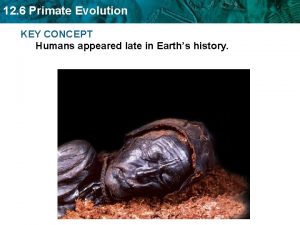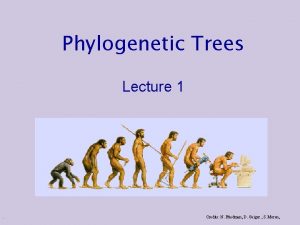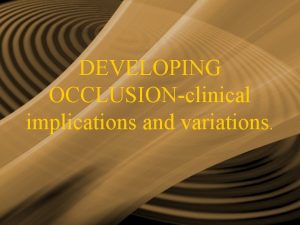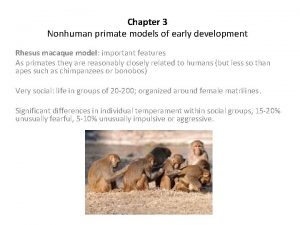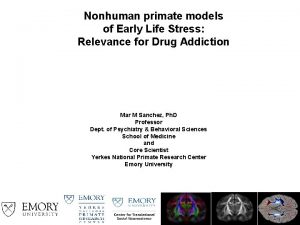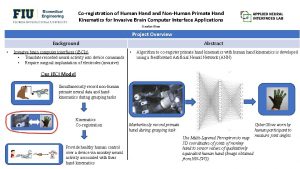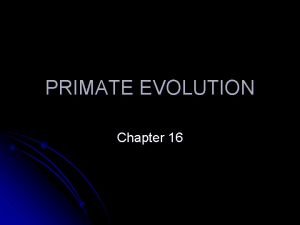NonHuman Primate Developmental GenotypeTissue Expression NHP d GTEx
















- Slides: 16

Non-Human Primate Developmental Genotype-Tissue Expression (NHP d. GTEx) Jennifer Troyer for the d. GTEx Working Group NHGRI: Jyoti Dayal, Joy Boyer, Laurie Findley, Simona Volpi NICHD: Tuba Fehr, John Ilekis, Danuta Krotoski, Melissa Parisi

Purpose of NHP d. GTEx Study gene expression patterns in multiple reference tissues across developmental stages in NHPs and compare them to human gene expression patterns • Determine common developmental networks and pathways • Identify developmental patterns that are primate- or human-specific • Establish datasets and samples for comparative developmental genomics • Inform model selection for functional and developmental studies 2

Genotype-Tissue Expression Projects • GTEx – Common Fund program (complete) o 838 postmortem adults, 49 tissues; DNA and RNA seq o Tissue-specific gene expression profiles, e. QTLs, highly used resource • d. GTEx – NHGRI, NICHD, NIMH, NINDS (beginning) o 120 postmortem infants and children, 30+ tissues; DNA and bulk and sc. RNA seq o Developmentally regulated tissue-specific expression o Impact of variation on development • d. GTEx NHP – NHGRI (proposed) o Experimentally tractable laboratory animals o Enable comparative developmental genomics o Build on developmental knowledge from model and other organisms 3

Developmental genomics in model systems WORM FRUIT FLY FROG SEA URCHIN ZEBRAFISH MOUSE 4

NHP advantages • Close relatives OWM • Similar development • Genomic diversity NWM • Biomedical models • Comparative genomics Biomedical Applications and Studies of Molecular Evolution: A Proposal for a Primate Genomic Library Resource. Evan E. Eichler and Pieter J. De. Jong 5

NHP d. GTEx Proposal 1 -2 NHP Centers $17. 5 M Over 5 years ($3. 5 M/year) • Expression data • Multiple developmental stages, tissues, species • May propose additional assays – single cell encouraged • Make data available and useable to the community • Use opportunistic and banked samples where possible 6

NHP d. GTEx Centers Provide Samples: 2 species (Old World and New World) X 6 stages (prenatal and postnatal) X 12 animals (male and female) X 30 tissues Generate Data: WGS for each animal, RNAseq for each tissue Manage Data: QC Basic analyses Other assays TBD Submission to appropriate resources 7

Leverage NHP Resources • National Primate Resource Center Consortium • 7 Centers supported by ORIP • Colonies from 10 species • Genomic resources/genetic diversity • High ethical standards for primate research • Behavior and phenotypic data • Banked tissue samples • NHP high quality reference genomes 8

Ensure Interoperability with d. GTEx • • NHP d. GTEx Centers Create tissue resource Generate genomic and gene expression data Data QC and management Make data available to the community NHGRI Tissue Procurement Center(s) • Recruitment • Pathology review • Clinical data collection • ELSI research NICHD LDACC • Laboratory • Data Analysis • Coordinating Center NHGRI

Considerations of balance • Multidimensional data • Developmental stages, individuals, tissues, assays, species • Data integration • New vs. existing resources • New data analysis methods 10

Questions • Is the balance right? How do we maximize the benefit of these samples? • Are there additional resources /opportunities for collaboration that we should be considering? 11


Genome structure and function Use evolutionary and comparative genomic data to maximize the understanding of genome function Addresses key strategic needs

Comparative genomics • Reduce noise and increase power in human studies • Filter for both conserved and specialized function • Correlate genomic differences with specific traits and phenotypes • Identify similarities across species in order to select appropriate laboratory models for specific human developmental processes and stages 14

Background-d. GTEx Study Design • Early post natal (0 -2 yrs) • Sequencing (WGS, RNA) • Childhood (2 -8 yrs) • Biospecimen collection • Pre-pubertal (8 -12. 5 yrs) (blood, bulk tissue and • Post-pubertal (12. 5 -18 yrs) single cell) • Chromatin accessibility • Histone modification • DNA methylation

Relationship to other projects • GTEx and d. GTEx • MODS and AGR • KO studies (KOMP, gnom. AD) • Clinical studies/resources that seek to interpret variants and their impact on development (Clin. Gen, UDN) • NHP genomic resources 16
 Study of the human and nonhuman features of earth
Study of the human and nonhuman features of earth Gives human characteristics to nonhuman objects
Gives human characteristics to nonhuman objects Kata ganti may
Kata ganti may The mix of human and nonhuman features at a given location
The mix of human and nonhuman features at a given location Quadratic formula examples
Quadratic formula examples Primate
Primate Primates characteristics
Primates characteristics Land whale
Land whale Borchert's epochs ap human geography definition
Borchert's epochs ap human geography definition Law of primate city
Law of primate city Primate evolutionary tree
Primate evolutionary tree Chapter 16 primate evolution assessment answer key
Chapter 16 primate evolution assessment answer key Primate
Primate Who created rank size rule
Who created rank size rule Spaces in primary dentition
Spaces in primary dentition Primate city countries
Primate city countries Primate taxonomy upsc anthropology
Primate taxonomy upsc anthropology





